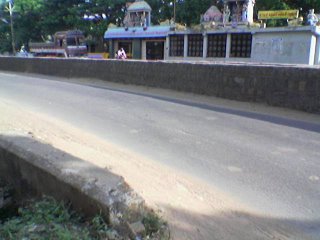Below I have pasted the full text of an interesting article I came across in US Newswire.
'The Asian Tsunami: A Protective Role for Coastal Vegetation'
by
Finn Danielsen, Mikael K. Sørensen, Mette F. Olwig, Vaithilingam Selvam, Faizal Parish, Neil D. Burgess, Tetsuya Hiraishi, Vagarappa M. Karunagaran, Michael S. Rasmussen, Lars B. Hansen, Alfredo Quarto, Nyoman Suryadiputra
originally published in Science .The summary of the findings is found in Newswire's article.
New Science Study: Mangroves Shielded Communities Against TsunamiTo: National Desk, Environment Reporter
Contact: Tom Lalley of the World Wildlife Fund, 202-997-0899 or tom.lalley@wwfus.org
WASHINGTON, Oct. 27 /U.S. Newswire/ -- A new study released today in the journal "Science" shows that areas buffered by coastal forests, like mangroves, were strikingly less damaged by the 2004 tsunami than areas without tree vegetation. This is believed to be the first peer-reviewed empirical and field-based study to document a clear link between coastal vegetation and protection from the tsunami. The study was undertaken by a large research team, comprising ecologists, a botanist, geographers, a forester, and a tsunami wave engineer, from seven nations.
"The tsunami left a horrific human tragedy in its wake but also some lessons. Among them is the tremendous importance of mangroves, which are one of the world's most threatened tropical ecosystems," said Faizal Parish, director of the Global Environment Centre in Malaysia and co-author. "While no one could have prevented the tsunami, we can use this experience to prevent some of the destruction future events will cause."
The study's authors used before and after satellite photographs of the Cuddalore District in southeastern India and surveys on the ground to reach their conclusions. The study confirms earlier laboratory experiments which have shown that 30 trees per 100 square meters may reduce the maximum flow of a tsunami by more than 90 percent.
The Cuddalore District provided a unique experimental setting to test the benefits of coastal forests against the tsunami. The shoreline there is relatively straight and the beach profile is relatively uniform. It also contains stretches of vegetated and non-vegetated areas and there are well-documented cloud-free pre- and post-tsunami satellite images."Coastal vegetation could probably not have protected against catastrophic destruction in areas of maximum tsunami intensity. In less hard hit areas, however, this study shows very clearly that areas with trees suffered less destruction than areas without trees," said Finn Danielsen, director at the Nordic Agency for Development and Ecology in Denmark and lead author.
While the study adds another important example to the list of key life support services provided by natural wetlands, the study's authors caution against blanket tree-planting programs. While in some cases these programs are useful to restore deforested areas, they can be counterproductive if beach ecology is disrupted. Some countries affected by the tsunami have initiated tree planting programs without fully considering their ecological impact.
Five of the villages examined in the study include two on the coast and three behind mangroves. The villages on the coast were completely destroyed, whereas those behind the mangrove suffered no destruction even though other areas unshielded by vegetation at the same distance from the coast were damaged. The study concluded that the forested areas protected the villages from tsunami damage by reducing the energy of waves.
"The sorrow I feel over the tsunami is magnified by the knowledge that a great deal of destruction could have been avoided," said Selvam Vaithilingam, programme director with the M.S. Swaminathan Foundation in Chennai, India and co-author. "In the five countries most affected by the tsunami, human activities reduced the area of mangroves by 26 percent between 1980 and 2000."
Although the study only looked at the 2004 tsunami, the study's authors say that the lessons from the tsunami are transferable to other extreme coastal events, such as storms. While tsunamis are relatively rare events, coastal storms occur many times every year and create significant destruction.
"Just as the degradation of wetlands in Louisiana almost certainly increased Hurricane Katrina's destructive powers, the degradation of mangroves in India magnified the tsunami's destruction," said Neil Burgess, a conservation specialist with World Wildlife Fund and a co-author. "Mangroves provide a valuable ecological service to the communities they protect."
Along with providing a buffer for tsunamis and storms, conserving or replanting mangroves also enhances fisheries and forestry production, benefits that man-made coastal protection structures do not provide. Mangroves and other coastal vegetation can be replanted relatively inexpensively. Mangroves are however suitable for planting only in certain locations where tidal currents and wave actions are not too strong, such as in former mangrove areas, behind coastal mudflats, in river estuaries and lagoons. . Elsewhere, the conservation of dune ecosystems or green belts of beach forest trees could fulfil the same protective role.
In response to the tsunami a number of organizations coordinated by the Malaysian based non-governmental organization Global Environment Centre have developed a Coastal Greenbelt Initiative to share experiences and resources between groups involved in rehabilitation of coastlines.
"Since the tsunami we have been working to help local communities to rebuild their lives and reestablish coastal vegetation in the areas affected by the tsunami in Aceh," said Nyoman Suryadiputra from Wetlands International-Indonesia and co-author of the study. "Local community members strongly support this action as they realize that areas with intact vegetation were less damaged."
The new "Science" study was funded by Solstice Foundation, Denmark.
Courtesy: US Newswire















